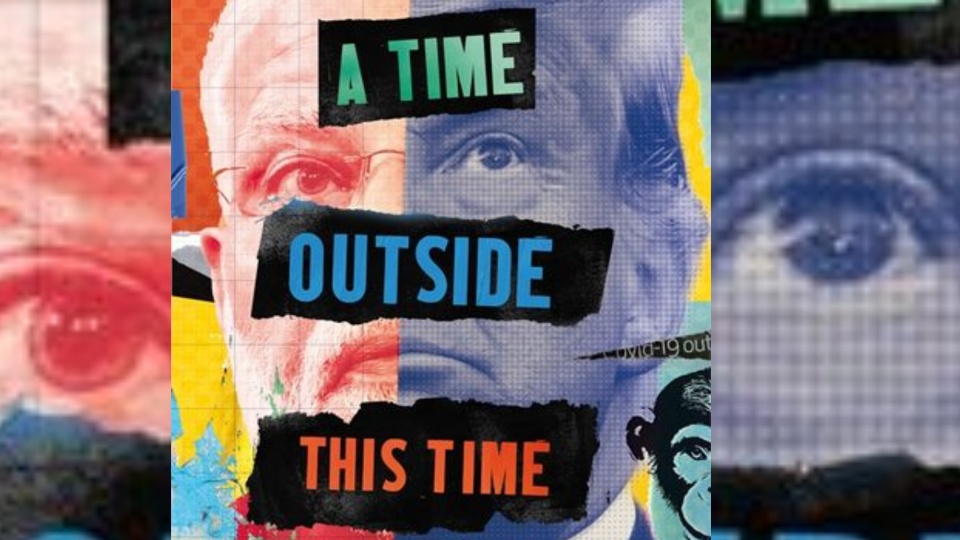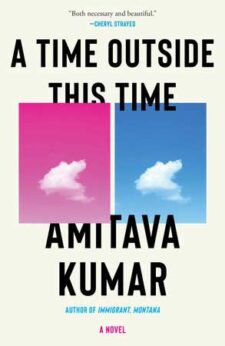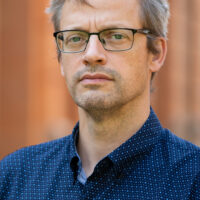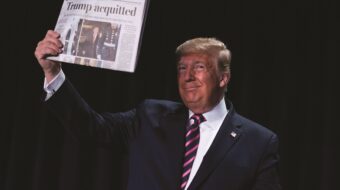
Sometimes the experience of violence and trauma induces memory loss. As U.S. residents prepare psychologically to relive the lies and trauma of the 2016 Trump campaign and presidency, and the fascistic nightmare of a possible second presidency, a quick visit to the archive of that time is necessary. Novelist Amitava Kumar’s A Time Outside This Time offers an urgent and compelling return to the record of actual events.
More than one million people in this country died during the pandemic that Donald Trump called a Democratic “hoax.” Instead of ordering scientifically valid measures to protect life, Trump openly and with infantile obstinance clashed with public health experts and preached fantasies about the pandemic’s quick end. He advocated unproven drugs and encouraged his fans to resist public health advisories and emergency measures. He demanded a dangerous early return to normal life. When his fans used violence and threats to protest public health measures, he cheered them on. Hundreds of thousands of lives could perhaps have been saved had the U.S. President used words and adopted policies more in line with scientific facts.
Before and during the pandemic, Trump generally platformed neo-Nazis, religious nationalists and advocates of lynching, and made open racism, xenophobia, and bigotry the central planks of his party’s platform. The evidence shows he planned and promoted a violent coup attempt at the U.S. Capitol on Jan. 6, 2021, in a fatal and unsuccessful attempt to restore his power. He made lying about anything and everything a political tool to compel submission, distort reality, and deny his complicity in the downhill slide into fascism.
 A Time Outside This Time is about a man writing a novel about the truth in the time of Trumpism. It unfolds through a journalistic prose style that conveys more fact than fiction. It is set mostly in a villa in Italy where the protagonist is attending a cushy writing retreat, with flashbacks to his past as a journalist in India and events in Washington and upstate New York where he teaches literature. The narrator’s references to scientific studies, news reports, actual events, living individuals, and real atrocities are so plentiful that I found myself Googling dozens of pieces of information that turned out to be true. About halfway through the novel, I realized that my active participation in the discovery of what was true and what was fictional in it may have been part of the author’s intention. It invoked a desire to fact-check, but also a realization about the easy way an armchair researcher might access “facts” based on Google’s search algorithms. Symptoms of the times.
A Time Outside This Time is about a man writing a novel about the truth in the time of Trumpism. It unfolds through a journalistic prose style that conveys more fact than fiction. It is set mostly in a villa in Italy where the protagonist is attending a cushy writing retreat, with flashbacks to his past as a journalist in India and events in Washington and upstate New York where he teaches literature. The narrator’s references to scientific studies, news reports, actual events, living individuals, and real atrocities are so plentiful that I found myself Googling dozens of pieces of information that turned out to be true. About halfway through the novel, I realized that my active participation in the discovery of what was true and what was fictional in it may have been part of the author’s intention. It invoked a desire to fact-check, but also a realization about the easy way an armchair researcher might access “facts” based on Google’s search algorithms. Symptoms of the times.
A novel about the news. Our narrator-protagonist, Satya (surname unknown), claims that “novel” and “news” have the same Latin root, foregrounding an irony about the factual nature of a novel and the fictional element of the news. Satya is a college professor and professional writer working on his next book, Enemies of the People, a title derived from Donald Trump’s denunciation of the media when they asked him hard questions he couldn’t answer without deception. His etymological exploration of those two words leads to the conclusion that his “essential work” is to write, gather the facts, and produce a work that allows readers to grapple with their own biases and the objectivity of truth.
A boot in your face
Kumar’s tale relates American experiences of Trump’s violent, lie-filled presidency to Narendra Modi’s rule in India. Modi has been compared to Trump: Both are regarded as authoritarian rulers who relied on mobilizing the racist, xenophobic, and religious bigotries of their supporters to promote conflict, creating the perception of a disorder that only their continued iron rule can manage. The linking of Modi’s exploitation of communalism in India with Trump’s platforming of neo-fascism in the U.S. signals the danger of globalized authoritarianism.
Initially, Satya believed that proper language construction could convince a reader of the truth and illuminate a path toward a good social order with justice. (Studies show, Satya discovers, objective reason and logic have little to do with what convinces us to believe or disbelieve something.) Instead, Satya sees his novel-in-progress move to a new level. It is a story that asks: “Who among your neighbors will look the other way when a figure of authority comes to your door and puts a boot in your face?”
A novel about a protagonist grappling with conflict in the era of “alternative facts” by writing a novel about social conflict and rulers’ lies using a journalistic style reveals a new social dynamic. It names an interaction of news and novelty that exposes the illusion of creating an insulated imaginary world through a story. But how can the protagonist write about social life using mere language? Language’s ability to fully express objective truth and the motion of social dynamics is limited. Language (a social relation) and objective truth (a perceptible object within and apart from social relations) are not identical things. The realization of language’s tendency to be manipulated by the powerful to preserve the brutality of class systems crystallized during the daily struggle over the truth that became a conspicuous feature of life under Trump. Because of his uncontrollable narcissism rooted in his class-based, fascistic desire for power and domination, language’s role in power surfaced, to the detriment of the whole U.S. political class. Trump’s mendacious habits led to a generalized struggle to keep hold of some semblance of reality.
The fact of that struggle, once hidden within layers of ideology, rose to society’s surface on a national scale. The role of lies, ideology, mystifications and mythologies in the political system, instead of an open secret, became the topic of news and novels. This new social feature exposed myths that justify racist violence, social inequality, and the wide social space between saying nice things about “essential workers” and denying them just financial compensation or additional social power. We learned that being essential to capitalist production couldn’t protect us from exploitation. We saw how language alone cannot represent reality fully, nor can it create or remake a reality. But it can provoke human action. Satya presumes that if that action is based on a language of truth, as much as it is possible to construct, people’s actions will be more oriented toward justice, and their humanity more enlisted in the project of social organization.
As this novel collapses the normal distance between the imaginary world of fiction and fascism’s real emergence, as we furiously Google this event or that person in the story, a single truth becomes more apparent. There is no time outside of this time: We are stuck in this reality, the same reality we must come to grips with in an objectively real and truthful way. Reason, truth, the right logic, or the right words, are not enough to transform that reality. The mode of production of language that seems to represent truth more accurately is truth assembly, the archival compilation of truthful snapshots of reality that may be combined over time, connected to reveal a social totality in motion.
While science, evidence, and logic are vital, they too are sequences of language. They often produce “seductive” narratives that simplify the complexity of human existence to small chunks of information. “[T]ruth doesn’t just exist by itself. It takes effort.” Still, despite his learning curve, Satya seems to be held back, even to the point of convincing himself that his sole, proper role is to write. When a #BlackLivesMatter protest in his hometown is organized after the murder of George Floyd, Satya volunteers to stay home: Fear of the pandemic, care for his young daughter’s safety, perhaps. But he isn’t compelled to put his body on the line, even as he values the courage of the hundreds of thousands of protestors who took to the streets in the middle of the 2020 lockdown. He seems to believe that he needs to protect some space between language and objective reality to see the latter at the distance required for writing honestly about it. The novel’s use of the contradiction between the human encounters involved with fact-finding labor that expose the journalist to tear gas and arrest, and Satya’s critical distance provided by fellowships and writing retreats, raises questions about the responsibilities of the writer.
If the proper ordering of words in the form of truth matters so little in the complexities of human relations and has little impact on changing what we believe about the world, why do it? Satya answers that he feels like he must make a record (as small in the scheme of things as it may be) that future historians will be able to discover, comb through, and use to create new fables and narratives about their past. This symbolic action—political interventions produced in the realm of language—may be matched by political action in the realm of human bodies (even if Satya declines the invitation). From objective reality, a struggle with language over truth swells into human action to change that reality. Trump and Modi and their followers sledgehammer this dialectic toward violence, destruction, and fantasies about the homogeneity of the political unit.
Our narrator-protagonist, along with us, his collective reader, imagines the possibility of this dialectic moving toward justice. While Satya hesitates at the entrance to the public square, his students do not. As the novel draws to a close, his student Ishaan, who had participated in the protests, has vowed to engage his classmates “about working on a project together,” to continue the struggle. He is motivated by a recorded history of struggle in his home country India, a narrative taught to him by his politically active father, but also by the physical and dangerous encounter with Trump fans who see the protesters as a dangerous threat to white supremacy.
The militants can organize and fight. As the El Salvadoran poet Roque Dalton wrote:
Y que mis venas no terminan en mí
sino en la sangre unánime
de los que luchan por la vida,
el amor,
las cosas,
el paisaje y el pan,
la poesía de todos….
My veins don’t end in me
but in the unanimous blood
of those who struggle for life,
love,
little things,
landscape and bread,
the poetry of everyone….
Amitava Kumar
A Time Outside This Time
Knopf, 2021, 272 pp.
ISBN 9780593319017












Comments